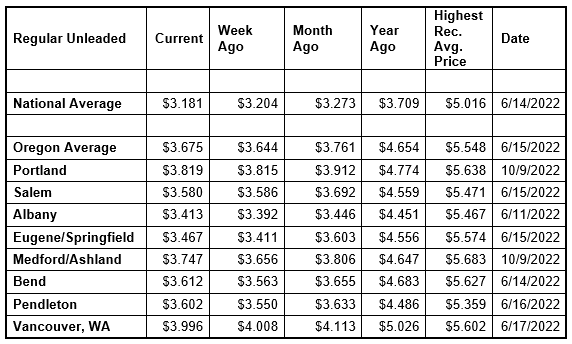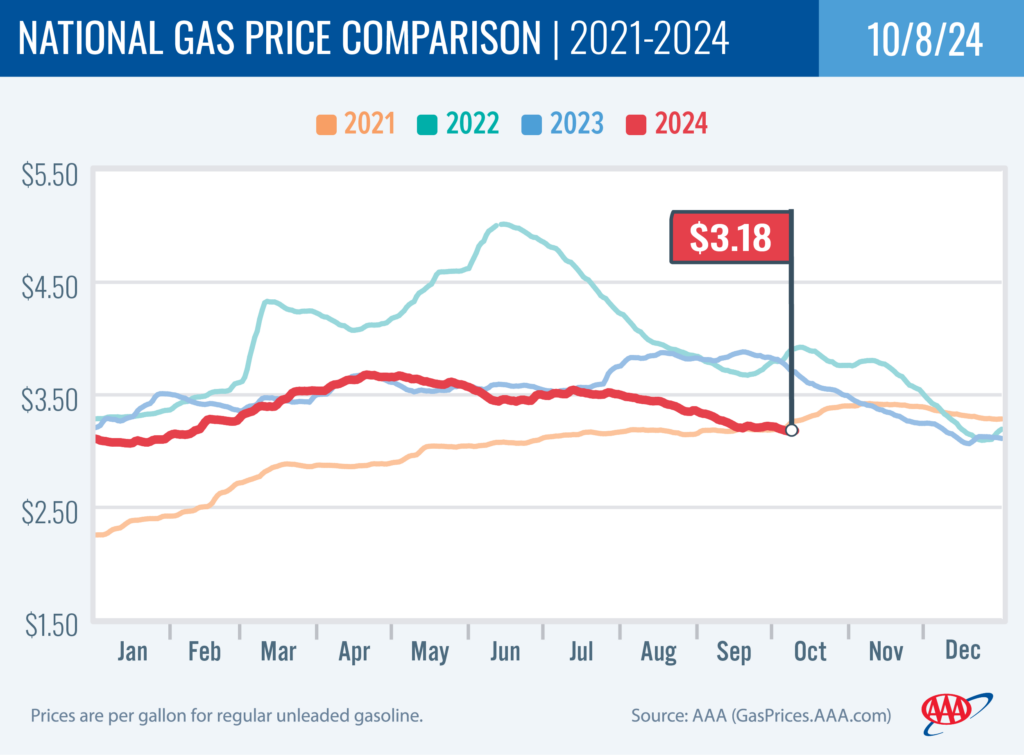Gas Prices Creep Up in 19 States including Oregon
PORTLAND, Ore., – Rising tensions in the Middle East have caused crude oil prices to rise, fueling small increases at the pumps in 19 states and slowing the declines in other states. Meanwhile, Hurricane Milton is expected to thrash Florida this week. Gas prices could see regional increases as drivers top-off vehicles while evacuating. For the week, the national average for regular edges down two cents to $3.18 a gallon. The Oregon average ticks up three cents to $3.68 a gallon.

Hurricane Milton is expected to make landfall late Wednesday night or early Thursday morning. Gas supplies are expected to tighten in Florida. Depending on the weather prior to the storm’s arrival, fuel deliveries could be reduced, limiting fuel supply at terminals and at local stations. The severity of the storm will determine access to fuel supply and impact on gas prices in Florida and the region following the storm. This should not impact pump prices here in the Pacific Northwest, but could put upward pressure on the national average. As in any national or local state of emergency, AAA expects gas prices to be held in check — up and down the gasoline supply chain — including prices set by refiners, distributors, and dealers.
“U.S. crude oil prices (West Texas Intermediate) climbed above $77 per barrel Monday, but have backed down to around $74 per barrel today. The rally has eased because Israel has not yet retaliated against Iran. However, oil prices will likely remain volatile due to fears of a growing war in the Middle East. WTI had remained in the upper $60s to low $70s for about a month.” says Marie Dodds, public affairs director for AAA Oregon/Idaho. “If crude prices remain elevated, we will likely see upward movement in pump prices.”
The escalating conflict between Israel and Iran may result in Iran’s oil production to be disrupted, which would impact regional and international supplies. Israel may target Iran’s oil infrastructure in retaliation for Iran’s ballistic missile attack on Israel last week. Iran produces about 3.4 million barrels of oil per day. At the same time, OPEC would have enough capacity to make up for the Iranian production. The U.S. currently produces the most crude oil of any nation, according to the U.S. Energy Information Administration.
The Oregon average began 2024 at $3.79 a gallon compared to $3.68 today. Its lowest price so far this year is $3.58 on February 14 and the highest is nearly $4.51 on May 1. The national average started the year at $3.11 and is at $3.18 today. Its lowest price so far this year is just under $3.07 on January 15 and the highest is just under $3.68 on April 19.
This week, only one Oregon county still has an average above $4 a gallon: Wallowa ($4.14).
Gas prices typically drop in the fall, due to the switch from summer-blend to winter-blend fuel, which costs less to produce. The switch starts in September. Many areas, including Oregon, can sell winter-blend fuel starting September 15. However, Northern and Southern California require summer-blend fuel through October 31.
Crude prices are impacted by economic news as well as geopolitical events around the world including the unrest in the Middle East and the war between Russia and Ukraine. In addition, production cuts by OPEC+ have tightened global crude oil supplies, which will continue to impact prices. Hurricane season can also impact crude oil prices, if a major storm impacts infrastructure in the Gulf of Mexico. Hurricane season runs from June 1 to November 30.
The price of crude oil reached the year-to-date high of nearly $87 per barrel on April 5. Major drivers of elevated crude prices have been the unrest in the Middle East, the decision by OPEC+ to keep oil production cuts in place, and Ukrainian attacks on Russian refineries. Russia is a top global oil producer, behind the U.S. and Saudi Arabia, and the refinery attacks have reduced output. Crude prices have been volatile after the attack on Israel by Hamas in October 2023. While Israel and the Palestinian territory are not oil producers, concerns remain that the conflict could spread in the Middle East, which could potentially impact crude production in other oil-producing nations in the region.
Crude oil is trading around $74 today compared to $70 a week ago and $86 a year ago. In 2023, West Texas Intermediate ranged between $63 and $95 per barrel. Crude reached recent highs of $123.70 on March 8, 2022, shortly after the Russian invasion of Ukraine, and $122.11 per barrel on June 8, 2022. The all-time high for WTI crude oil is $147.27 in July 2008.
Crude oil is the main ingredient in gasoline and diesel, so pump prices are impacted by crude prices on the global markets. On average, about 55% of what we pay for in a gallon of gasoline is for the price of crude oil, 13% is refining, 17% distribution and marketing, and 15% are taxes, according to the U.S. Energy Information Administration.
Demand for gasoline in the U.S. plummeted from 9.20 million b/d to 8.52 million b/d for the week ending September 27, according to the U.S. Energy Information Administration (EIA). This compares to 8.01 million b/d a year ago. Meanwhile, total domestic gasoline stocks rose from 220.1 to 221.2 million barrels. Gasoline production decreased last week, averaging 9.6 million barrels per day compared to 9.8 million barrels the previous week.
Crude oil production in the U.S. is at 13.3 million barrels per day, according to the EIA. This remains near the record high of 13.4 million barrels per day last reached in August of this year. The U.S. produces more crude oil than any other country, according to the EIA.
If crude oil prices remain elevated, gas prices may rise. However, tepid gasoline demand and cheaper winter-blend fuel should put downward pressure on prices in the coming weeks.
Quick stats
Oregon is one of 19 states and the District of Columbia with higher prices now than a week ago. Virginia (+7 cents) has the biggest week-over-week increase in the nation. Georgia (-23 cents) has the largest weekly decrease.
California ($4.68) has the most expensive gas in the nation for the fifth week in a row. Hawaii ($4.58) is second, and Washington ($4.04) is third. These are the three states with averages at or above $4 a gallon, same as a week ago. This week 31 states and the District of Columbia have averages in the $3-range. There are 16 states with an average in the $2 range this week.
The cheapest gas in the nation is in Mississippi ($2.70) and Georgia ($2.73). No state has had an average below $2 a gallon since January 7, 2021, when Mississippi and Texas were below that threshold.
The difference between the most expensive and least expensive states is $1.98 this week, compared to $2.00 a week ago.
Oregon is one of 46 states and the District of Columbia with lower prices now than a month ago. The national average is nine cents less and the Oregon average is nine cents less than a month ago. Georgia (-34 cents) has the largest month-over-month drop in the nation. Delaware (+10 cents) has the largest monthly increase in the nation.
All 50 states and the District of Columbia have lower prices now than a year ago. The national average is 53 cents less and the Oregon average is 98 cents less than a year ago. This is the fifth-largest year-over-year drop in the nation. Arizona (-$1.18) has the largest year-over-year drop.
West Coast
The West Coast region continues to have the most expensive pump prices in the nation with six of the seven states in the top 10. It’s typical for the West Coast to have six or seven states in the top 10 as this region tends to consistently have fairly tight supplies, consuming about as much gasoline as is produced. In addition, this region is located relatively far from parts of the country where oil drilling, production and refining occurs, so transportation costs are higher. And environmental programs in this region add to the cost of production, storage and distribution.
As mentioned above, California ($4.68) has the most expensive gas in the country. Hawaii, Washington, Nevada, Oregon, and Alaska round out the top six. Arizona ($3.33) is 13th. Oregon is fifth for the eighth week in a row.
All seven states in the West Coast region are seeing small changes in gas prices decline on the week: Oregon (+3 cents), Arizona (+1 cent), and Washington (+1 cent) have small increases. Hawaii (-2 cents), Alaska (-1 cent), California (-3/10ths of a cent), and Nevada (-2/10ths of a cent) have small increases.
The refinery utilization rate on the West Coast slipped from 90.6% to 89.2% for the week ending September 27. This rate has ranged between about 74% to % in the last year. The latest national refinery utilization rate dipped from 90.9% to 87.6%. The refinery utilization rate measures how much crude oil refineries are processing as a percentage of their maximum capacity. A low or declining rate can put upward pressure on pump prices, while a high or rising rate can put downward pressure on pump prices.
According to EIA’s latest weekly report, total gas stocks in the region climbed from 26.44 million bbl. to 27.30 million bbl.
An decrease in the refinery utilization rate and/or a low rate can put upward pressure on pump prices, and an increase in gasoline stocks can put downward pressure on pump prices.
Oil market dynamics
Crude oil prices (West Texas Intermediate) soared to $77 per barrel to start this week on fears of a widening conflict in the Middle East, with Israel poised to strike Iran’s oil infrastructure in retaliation for Iran’s missile attack on Israel last week. Today, WTI has backed off to around $74 per barrel as Israel has not retaliated against Iran yet. Meanwhile, the EIA reports that crude oil inventories increased by 3.9 million barrels from the previous week. At 416.9 million barrels, U.S. crude oil inventories are about 4% below the five-year average for this time of year.
At the close of Friday’s formal trading session, WTI added 67 cents to settle at $74.38. At the close of Monday’s formal trading session, WTI jumped $2.76 to settle at $77.14. Today crude is trading around $74 compared to $70 a week ago. Crude prices are about $12 less than a year ago.
Drivers can find current gas prices along their route with the free AAA Mobile app for iPhone, iPad and Android. The app can also be used to map a route, find discounts, book a hotel and access AAA roadside assistance. Learn more at AAA.com/mobile.

Diesel
For the week, the national average adds two cents to $3.59 a gallon. The record high is $5.816 set on June 19, 2022. The Oregon average climbs three cents to $3.91. The record high is $6.47 set on July 3, 2022. A year ago the national average for diesel was $4.52 and the Oregon average was $5.11.
Find current fuel prices at GasPrices.AAA.com.
AAA news releases, high resolution images, broadcast-quality video, fact sheets and podcasts are available on the AAA NewsRoom at NewsRoom.AAA.com.
Find local news releases at https://oregon.aaa.com/community/media/media-contacts.html
Fuel prices are updated daily at AAA’s Daily Fuel Gauge at AAA Gas Prices. For more info go www.AAA.com. AAA Oregon/Idaho provides more than 900,000 members with travel, insurance, financial and automotive-related services, and is an affiliate of AAA National, serving more than 64 million motorists in North America.

